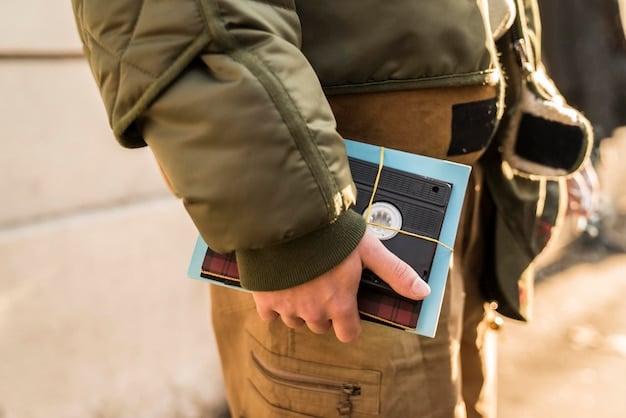US Border Crossing: Land and Sea Travel Requirements in 2024

Understanding **US border crossing requirements** for land and sea travel is essential for a smooth journey, involving proper documentation like passports or enhanced driver’s licenses, and adherence to customs regulations.
Planning a trip across the US border? Navigating the **US border crossing requirements** can seem daunting, but understanding the essentials for both land and sea travel can ensure a smooth, stress-free experience.
Understanding US Border Crossing Requirements for Land and Sea
Crossing the US border, whether by land or sea, involves adhering to specific regulations and presenting the required documentation. These requirements are in place to ensure security and facilitate the smooth flow of legal travel. Knowing what to expect can significantly reduce potential delays and complications.
This article will delve into the specifics of **US border crossing requirements**, covering everything from acceptable forms of identification to customs regulations. By understanding these guidelines, travelers can prepare effectively and enjoy hassle-free border crossings.

Acceptable Documents for US Border Entry
One of the most crucial aspects of crossing the US border is possessing the correct documentation. The specific documents required depend on your citizenship, the mode of transportation (land or sea), and the purpose of your visit.
For US citizens, a valid US passport is generally the most reliable and universally accepted document. However, alternative options may be available for land and sea crossings.
Passport Requirements for US Citizens
US citizens returning to the United States by air are required to present a valid US passport. While passports are not always mandatory for land and sea crossings from Canada and Mexico, they are highly recommended to avoid potential delays and ensure smooth reentry.
Alternative Documents for Land and Sea Crossings
For land and sea crossings, US citizens have several alternative document options, including:
- Passport Cards: Designed specifically for land and sea travel between the US, Canada, Mexico, and the Caribbean.
- Enhanced Driver’s Licenses (EDLs): Issued by certain states (Michigan, Minnesota, New York, Vermont, and Washington), EDLs are accepted for land and sea crossings.
- Trusted Traveler Program Cards: Such as NEXUS, SENTRI, and FAST cards, which provide expedited processing at land and sea borders.
Having the correct documents is paramount for a seamless border crossing experience. Ensure your documents are valid and readily accessible when approaching the border.
Crossing by Land: What to Expect
Land border crossings between the US, Canada, and Mexico are common, but they require careful preparation. Knowing the procedures and potential challenges can help travelers navigate these crossings efficiently.
From inspection processes to understanding what items need to be declared, preparation is key to a smooth land border crossing.

Inspection Process at Land Borders
When crossing the US border by land, you will typically encounter the following steps:
- Initial Contact: A border officer will ask you about your citizenship, purpose of travel, and items you are bringing into the US.
- Document Verification: The officer will examine your passport or other acceptable form of identification.
- Vehicle Inspection: The officer may inspect your vehicle for contraband or undeclared items.
Tips for a Smooth Land Border Crossing
To facilitate a smooth land border crossing, consider these tips:
- Be Prepared: Have your documents readily available and be prepared to answer questions about your trip.
- Declare Everything: Declare all items you are bringing into the US, including food, alcohol, and gifts.
- Be Honest: Provide truthful answers to the border officer’s questions.
Understanding the inspection process and following these tips can help streamline your land border crossing experience.
Crossing by Sea: Navigating Maritime Borders
Entering the US by sea involves a different set of procedures compared to land crossings. Whether you’re arriving on a cruise ship, private vessel, or commercial ship, understanding the maritime border requirements is essential.
Maritime border crossings involve specific reporting requirements and adherence to regulations that differ from land travel. Let’s examine them in detail.
Reporting Requirements for Vessels
All vessels arriving in the US from a foreign port are required to report their arrival to US Customs and Border Protection (CBP). This can be done through various channels, including:
- CBP Reporting Offsite Arrival – Mobile (CBP ROAM) app: For small pleasure vessels.
- Electronic Notice of Arrival (eNOA): For commercial vessels.
Passenger and Crew Manifests
Vessels are also required to submit passenger and crew manifests to CBP. These manifests provide information about everyone on board, including their citizenship and travel documents.
Navigating maritime borders requires strict adherence to reporting requirements and passenger manifest regulations. Failure to comply can result in penalties and delays.
Customs Regulations and Declarations
Understanding US customs regulations is crucial for all border crossings, whether by land or sea. These regulations govern what items you can bring into the US and how much you can bring without paying duty.
Customs regulations are designed to protect US interests by controlling the flow of goods across borders. Declarations are a critical part of this process.
What Items Need to Be Declared?
When entering the US, you must declare all items you acquired abroad, including:
- Gifts: Items you intend to give as gifts.
- Merchandise: Items you purchased for resale or commercial use.
- Alcohol and Tobacco: Quantities exceeding personal use exemptions.
Duty Exemptions and Restrictions
US residents are generally entitled to a duty exemption, which allows them to bring a certain amount of goods into the US without paying duty. The amount of the exemption depends on the length of your stay abroad and the country you are returning from.
Adhering to customs regulations and accurately declaring items is essential to avoid penalties and ensure a smooth border crossing experience.
Traveling with Pets and Animals
For many, traveling isn’t complete without their furry companions. However, bringing pets across the US border requires careful planning and adherence to specific regulations set by the Centers for Disease Control and Prevention (CDC) and the US Department of Agriculture (USDA).
Specific health requirements and documentation are necessary for pets entering the US. These regulations vary based on the type of animal and the country of origin.
Requirements for Dogs
Dogs entering the US must generally be vaccinated against rabies and have a valid rabies vaccination certificate. Additional requirements may apply depending on the country of origin.
Requirements for Cats
While not required to be vaccinated against rabies by federal law, some states may have their own rabies vaccination requirements for cats. Check with the relevant state health department for specific regulations.
Traveling with pets requires careful planning and adherence to specific health and documentation requirements. Always check the latest regulations from the CDC and USDA before your trip.
Frequently Asked Questions About US Border Crossings
Navigating the US border can raise many questions for travelers. Understanding the answers to these common inquiries can help alleviate concerns and ensure a smoother journey.
Here are some of the most frequently asked questions about **US border crossing requirements**, along with detailed answers to help you prepare.
| Key Point | Brief Description |
|---|---|
| 🛂 Required Documents | Passport, passport card, or enhanced driver’s license needed. |
| 🚢 Sea Travel | Report arrival via CBP ROAM app or eNOA; submit manifests. |
| 🐕 Pet Travel | Vaccination certificates and health documents required. |
| 💰 Customs | Declare all items acquired abroad to avoid penalties. |
Frequently Asked Questions
While a passport is not always required for US citizens crossing by land or sea from Canada and Mexico, it is highly recommended. Alternative documents like passport cards or enhanced driver’s licenses are also accepted.
An EDL is a special driver’s license issued by certain states (Michigan, Minnesota, New York, Vermont, and Washington) that serves as proof of identity and citizenship, accepted for land and sea crossings to the US from Canada and Mexico.
Vessels arriving in the US by sea must report their arrival to US Customs and Border Protection (CBP) using the CBP ROAM app for small pleasure vessels or the Electronic Notice of Arrival (eNOA) for commercial vessels.
You must declare all items you acquired abroad, including gifts, merchandise, alcohol, and tobacco. Failure to declare items can result in penalties and seizure of the undeclared goods.
Yes, there are restrictions on bringing certain types of food into the US, particularly fresh fruits, vegetables, and meat products. Check the USDA’s website for specific restrictions based on the country of origin.
Conclusion
Understanding and adhering to **US border crossing requirements** for both land and sea travel is essential for a smooth and stress-free journey. By ensuring you have the correct documentation, declaring all necessary items, and staying informed about the latest regulations, you can navigate the border with confidence. Always verify requirements with official sources before your trip to account for any potential changes.





